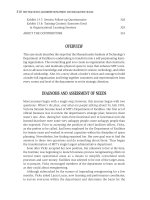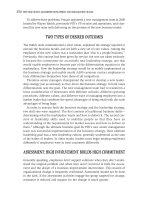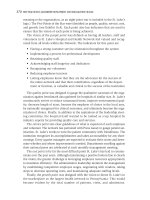Tài liệu Best Practives in Leadership Development & Organization Change 7 doc
Bạn đang xem bản rút gọn của tài liệu. Xem và tải ngay bản đầy đủ của tài liệu tại đây (157.92 KB, 10 trang )
30
BEST PRACTICES IN LEADERSHIP DEVELOPMENT AND ORGANIZATION CHANGE
Corning Competes
Immediately following Houghton’s address to the Industrial Research Institute
(1993), Corning launched Corning Competes, a program designed to reengineer
its key business processes. Deliberate in its choice to reengineer rather than
restructure, Corning Competes represented a reinvestment in Corning’s business
processes through continuous improvement of best practices. It also provided
the necessary tools for better communication among the technical and business
constituencies. The company needed to enhance its capability to compete for
present and future business while improving its financial performance.
As the innovation process was the number one cost of quality in the company,
the goal of the Corning Competes innovation effectiveness team was to enable
Corning to get the most from its innovation investment in product and process
technologies. To ensure that the company was well positioned for growth and prof-
itability, the team sought to “reengineer the process by which Corning creates,
identifies, evaluates, prioritizes, and executes against market opportunities.”
Equally pressing within the technology community was the need to drive dis-
continuous improvement—to instill a “step change” within the continuum of
best practice continuous improvement. The company had to manage a culture
change that would enable it to strike a balance between continuous improve-
ment and the step changes necessary to deliver breakthrough technologies.
Some of Corning’s greatest profit-producing technology breakthroughs had come
from just that—from achieving that delicate balance between incremental
improvements on the one hand and breakthrough invention on the other, thus
leading to new product and process commercialization. Going forward, this kind
of innovation would be “the ticket” for Corning.
Innovation Today
The continued focus on innovation at Corning today—with an ever-evolving,
dynamic process featuring pronounced cross-functional and cross-disciplinary
integration—has allowed the company to make decisions faster and closer to
the point of action. Implemented flexibly yet with rigor, the innovation process
allows people and projects to overcome both internal and external barriers, to
be agile—gaining, sharing, and acting on new information and insights—
provide more opportunities to innovate, reduce product development time, and
enhance customer relationships. In short, it allows the company to outlearn
and lead the competition.
Through generations of change at Corning, innovation is the sustaining thread
throughout. “Innovation is in Corning’s DNA,” says Charlie Craig. It is what
allows the company to reinvent itself—most often through the reuse of its
technology—which it has done sixteen times in its 151-year history. The company
champions and nurtures innovation; it uses innovation as a means to succeed.
cart_14399_ch02.qxd 10/19/04 11:28 AM Page 30
CORNING
31
Here is a current example. One way Corning is dealing with the telecom-
munications industry collapse, in which an entire market disappeared
seemingly overnight, is to repurpose and redirect its investment in intellectual
property around optical technologies, clearly into a technology that is non-
telecommunications related.
Another use of a core technology resulted in EAGLE
2000TM
, a prime example
of innovation at Corning today—innovation at its best.
Background
Innovation has always been the hallmark of our success.
—Jamie Houghton
Corning has a long tradition of building on and reusing its existing technology
and knowledge bases to innovate and create new business opportunities. An
important example is the “fusion process,” developed in the early 1960s by
Corning engineers. Initially used in combination with a newly developed mate-
rial, Chemcor (chemically strengthened glass for manufacturing automobile
windshields), the fusion process lived on when the windshield market did not
materialize for Corning.
During the 1970s, Corning scientists at the company’s research facility in
Fontainebleau, France, used the fusion process to manufacture sunglass lenses.
Long a supplier of tubes to the television industry, Corning began to look for
ways to extend its presence in the display markets. Using the fusion process, it
began producing flat panel glass for liquid crystal display applications, such as
laptop computers.
As the markets for laptops, PDAs (personal digital assistants), flat screen
monitors, and flat screen televisions began to grow in the 1990s, Corning sci-
entists and engineers continued to use the innovation process and the Fusion
process to meet the demands of its customers. EAGLE
2000TM
is an excellent
example of the use of both processes.
Contemporary Success Story: Innovation at Its Best
The results for EAGLE
2000TM
have been fantastic. Not only did this project use the
Innovation Process to meet the customers’ demands for lighter weight displays, it
also improved our capacity and profitability as well.
—Randy Rhoads, project manager
We had interesting joint sessions very early on. Manufacturing,
technology, and marketing worked very, very closely on this—in the first
stages with product development, the detailing of the product, and what
the customers really required.
—Dan Nolet, display technologies
cart_14399_ch02.qxd 10/19/04 11:28 AM Page 31
32
BEST PRACTICES IN LEADERSHIP DEVELOPMENT AND ORGANIZATION CHANGE
With its combination of glass properties and manufacturing technology, Corning
EAGLE
2000TM
flat glass substrates enable active matrix liquid crystal display
(AMLCD) manufacturers to make larger, lighter, thinner, and higher-resolution
displays for computer monitors and home entertainment. This glass has the
industry’s lowest thermal expansion, thus decreasing the effects of thermal
down shock and breakage, and due to its remarkably low-density composition
Corning EAGLE
2000TM
glass is the lightest AMLCD substrate on the market.
EAGLE
2000TM
also has improved chemical durability over earlier substrate
glasses, which minimizes glass damage during the harsh chemical processes
involved with display manufacturing. Corning EAGLE
2000TM
glass is made using
Corning’s fusion process. This close-tolerance glass draw process, combined
with Corning’s patented composition, yields glass with truly remarkable quali-
ties: pristine, near-perfect flat surfaces with improved thickness variations that
don’t require polishing.
By participating early in the innovation process, the manufacturing group—
along with marketing and technology—ensured that the production-delivery
process design accommodated all key operational performance requirements. A
strong, cross-functional team was established right from the start. This early
involvement helped the team avoid many of the later-stage issues that often
arise when the manufacturing function is not an active participant in the early
innovation stages. In this way, they were able to influence the design so it
allows a more robust manufacturing process (see Figure 2.3).
While marketing conducted an extensive study to identify and quantify the
customers’ requirements, manufacturing defined the performance range of
Advanced Display processes, so that technology was able to identify the vari-
ous compositions that would not only meet customer needs, but would also
work within manufacturing’s current and expected parameters.
Figure 2.3 Manufacturing Process.
Source: Copyright
©
Corning Incorporated. Reprinted by permission.
I.
Build
knowledge
II.
Determine
feasibility
III.
Test
practicality
IV.
Prove
profitability
V.
Manage
life cycle
Concept
plan
Evaluate
opportunity
Evaluate
concept
Confirm
concept
Confirm
profitability
Development
plan
Profitability
plan
Commercialize
plan
Life cycle
plan
cart_14399_ch02.qxd 10/19/04 11:28 AM Page 32
CORNING
33
The EAGLE
2000TM
product team noted the following additional benefits of
using the innovation process:
• The common language and understanding of the five stages made it
easier to accommodate the many personnel changes that occurred
throughout the project. It also provided the framework to hold their
global team together.
• The cross-functional team from the start enabled all functions to actively
participate in the development of the project objectives. The shared
ownership of the project objectives helped guide the project effectively
throughout the five stages
• The team, by proactively using risk management, had the ability to find
a balance between market requirements, manufacturing capabilities, and
technical competencies. The key for EAGLE
2000TM
was to find common
denominators for all three areas.
• The five-stage suggested activities helped outline the required work and
deliverables for their planning process.
ON-THE-JOB SUPPORT: REINFORCING
THE REINFORCEMENTS
The innovation process has evolved well beyond the rudimentary model we
adopted two decades ago . . . and is now embedded in our culture.
—Joe Miller
On an ongoing and consistent basis, Corning requires employees on project
teams to take its innovation training and follow a comprehensive set of guide-
lines and tools toward product innovation. The company has progressively broad-
ened the training to more teams and functional units, “spreading the language
of our business.” Corning also renews its innovation process periodically—most
recently, for instance, to manage the innovation “pipeline” for new opportuni-
ties, g risk assessment, costs, and value added (see Figure 2.4).
Innovation Effectiveness
These innovation effectiveness processes are the underpinning for the
growth of our company.
—Charles “Skip” Deneka, CTO, 1996–2001
Innovation effectiveness is the umbrella term for Corning’s innovation effort.
“Innovation effectiveness encompasses identifying opportunities (roadmapping),
selecting opportunities (portfolio decision making), delivering opportunities
(innovation project management) in order to realize benefit (dollars), and
cart_14399_ch02.qxd 10/19/04 11:28 AM Page 33
34
BEST PRACTICES IN LEADERSHIP DEVELOPMENT AND ORGANIZATION CHANGE
staying closely connected to customers and markets” (Bruce Kirk, corporate
innovation effectiveness leader).
Innovation effectiveness requires
• Understanding the overall corporate and business strategies
• Developing sound roadmaps based on understanding customers,
markets, competitors, and Corning’s strengths and weaknesses and
estimating resources required for each project submitted to the portfolio
management process for funding
• Applying the portfolio management process to evaluate, prioritize, and
select projects
• Executing the selected projects well
Ideas into Dollars
The following list and Figure 2.5 describe Corning’s best practice for enabling
successful and innovative projects.
• Roadmapping. Anticipating and planning for future opportunities.
Requires customer focus and forward-looking thinking.
• Project portfolio. Selecting the best opportunities, balancing the risks and
benefits, and allocating critical resources. Applying process rigor while
retaining flexibility to exercise judgment.
• Innovation project management. Moving a product, process, or
service idea iteratively through the stages of innovation to successful
commercialization (dollars). Reduces development time, increases
the number of commercially successful products, and cancels the
Figure 2.4 Corning Innovation Pipeline.
Source: Copyright
©
Corning Incorporated. Reprinted by permission.
Knowledge Building and Organizational Learning - All Along Pipeline
Ideas
Spin-out/Sell
Licensing
External partnerships/
acquisitions
External
technology sources
Major
opportunities
cart_14399_ch02.qxd 10/19/04 11:28 AM Page 34
CORNING
35
Source: Copyright
©
Corning Incorporated. Reprinted by permission.
New Corning products (less than four years old) as a percentage of market share
1995 1998 1999 2000 2001 2002 2003
30
57
78
84
82
83
88
Figure 2.5 Ideas into Dollars.
Source: Copyright
©
Corning Incorporated. Reprinted by permission.
Customer and market understanding
Roadmapping
Opportunities
$
Project
portfolio
Selections
Innovation
project
management
Executions
Table 2.1. Innovation Delivery
cart_14399_ch02.qxd 10/19/04 11:28 AM Page 35
36
BEST PRACTICES IN LEADERSHIP DEVELOPMENT AND ORGANIZATION CHANGE
less-promising projects earlier. This is the five-stage Stage-Gate
TM
innovation process, referenced earlier.
• Customer and market understanding. Truly understanding customers,
markets, competitors, and anticipating their actions and reactions. The
underpinning of the other three innovation elements.
Evaluation
At Corning, a significant measurement of the innovation effectiveness process
is the percentage of sales of new products from R&D. Since 1998, Corning has
delivered no less than 57 percent of its products to the marketplace within four
years. That is a remarkable accomplishment by any corporate standard.
THE LEARNING MACHINE: DRIVING SUSTAINABLE
VALUE AND GROWTH
The innovation process is a learning machine that drives the company’s sus-
tainable value and growth (see Figure 2.6). Corning’s focus on quality and
knowledge-sharing tools and practices provides the “rate-change enablers” that
Figure 2.6 Innovation Process.
Source: Copyright
©
Corning Incorporated. Reprinted by permission.
Sustainable
value and growth
Innovation
Knowledge
management
Organizational
learning
cart_14399_ch02.qxd 10/19/04 11:28 AM Page 36
CORNING
37
increase the rate of organizational learning—bringing Corning differential value
and competitive advantage—and, in turn, increases the rate of innovation.
The Learning Machine: Providing New Angles on Insight
Without being overly prescriptive or bureaucratic, Corning encourages sharing
of knowledge in the following ways. This has promoted a short cycle “learning
machine,” which allows colleagues to share and test data and best practices.
• Morning meetings
A forum to share proprietary research results in progress
Thirty-minute talk on work or current state of the science or project
Additional time scheduled for Q&A and discussion
Audience and speaker exchange ideas and gain insights
• Technical tutorials
Education on a technology, including orientation, strategy, technical
components
Offered at multiple levels
Encourages tacit knowledge exchange
• Research reviews
Enable business leaders and technology community members to stay
abreast of rapidly changing technologies and market trends
Two hours in length, with time for interaction within the technology
community, as well as with the business partners
Begin with opening remarks by the specific project leader, followed by
presentations by key project members
• Communities of practice
Individuals who come together over a common interest, one that could
be directly or indirectly related to their current work
Formal (sanctioned); for example, Centers of Excellence
Informal (grass roots); for example, software programmers
Knowledge Management and Organizational Learning
These knowledge-sharing tools and practices are only a few of many examples
that have emanated from within the technology community. They demonstrate
how innovation is coupled with other ongoing Corning business practices into
everyday activities and processes, providing new insights for Corning. Scientists,
engineers, technicians, and commercial managers share knowledge, experience,
cart_14399_ch02.qxd 10/19/04 11:28 AM Page 37
and perspective on a regular basis. In doing so, they optimize, leverage, and
re-use this key knowledge, experience, and perspective—all critical components
of learning—within a technology context. For Corning, this translates into new
product and process innovation—ideas into dollars.
A key ongoing goal of Corning’s learning machine is to increase its knowl-
edge re-use quotient. To do this, the company increases the number of perspec-
tives (people and disciplines) within the organization, improves interdisciplinary
sharing (the number of interactions that occur among disciplines), and provides
the necessary tools to synthesize all those interactions to reformulate the com-
pany’s knowledge for re-use. Corning also includes tactical elements such as
ergonomics and facilities design to ensure that these interactions occur; for
example, secure video conferencing, facilities, and informal meeting areas.
Increasing the knowledge re-use quotient means the real-time tapping of insti-
tutional knowledge and memory through people in a global culture and in
everyday circumstances within the workplace.
Another key element is building the knowledge (technology) warehouse.
This is basically an archive—a technology cupboard—from which one can
research, identify, and access technology for re-use. At Corning, technology
investments are never lost: they are either shelved as tangible objects
(samples, patents, technical reports, lab notebooks) or accessed through the
intangible, tacit corporate memory through storytelling, oral histories, and
other everyday means. The company constantly builds its knowledge cache,
“packages” it in a complete, relevant form, and trains its employees how to
access it for further use—a way to preserve and build upon its core compe-
tencies and critical capabilities. The innovation process—an iterative process—
is the learning catalyst; it is what ties together both modes of learning into a
“learning machine.”
Enhancing the Learning Culture: Building Bridges
to Enable Innovation
In order to create and sustain the learning culture to enable innovation, bridges
must be built. An example would be a move toward bridging manufacturing
effectiveness with innovation effectiveness through process engineering (see
Figure 2.7). Another leading example would be the bridging of two traditionally
disparate internal initiatives—manufacturing process improvement and the
knowledge management and organizational learning effort—focusing on
the unifying theme of innovation. Doing so will provide a real-time opportunity
to address pressing process technology issues facing Corning today—in short,
an opportunity to drive improved profitability now, reinvigorate quality, and be
“ready” for the next upturn.
This type of interactive, dynamic collaboration will yield for the company not
only the standard cost containment, greater resource availability, and larger
internal target audiences, but will also help ensure the company’s stability
38
BEST PRACTICES IN LEADERSHIP DEVELOPMENT AND ORGANIZATION CHANGE
cart_14399_ch02.qxd 10/19/04 11:28 AM Page 38
CORNING
39
and growth. It will help rebuild the network, enhance the learning culture, and
expand technical know-how through optimizing synergies.
Learning Coaches: Establishing a New Core
Competency in R&D
The only way to make sure the culture and discipline are
sustained is to have an experienced advisor present.
Our Learning Coach Center of Excellence will ensure
company wide implementation and learning.
—Charlie Craig
Once the elements of the learning culture are in place, and the organization
understands how it learns most effectively, the process is catalyzed with learn-
ing coaches, similar to Six Sigma black belts. These are individuals whose role it
is to become knowledge networking “agents” or learning facilitators within the
organization. Part of a Learning Coach “center of excellence” or virtual commu-
nity of practice, they are trained as innovation project managers and are highly
skilled at process excellence around innovation effectiveness and how people
learn. These learning coaches join teams and prompt them to share knowledge,
cross boundaries, learn together, and become more effective collaborators.
Figure 2.7 Accelerating Learning by Building Bridges Across Organizations.
Source: Copyright
©
Corning Incorporated. Reprinted by permission.
Commercial
Manufacturing
effectiveness
Process
engineering
Innovation
effectiveness
Industrial and
Labor relations
Operational
optimization
Safety and
environmental
Legal/
Intellectual
property
Product
development/
Design
cart_14399_ch02.qxd 10/19/04 11:28 AM Page 39









